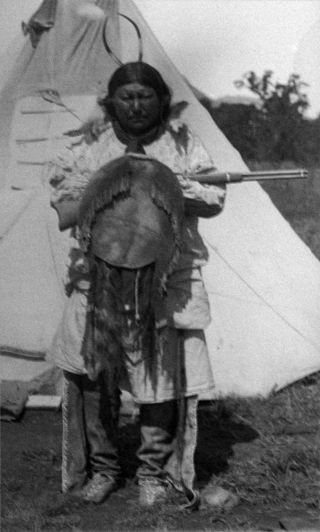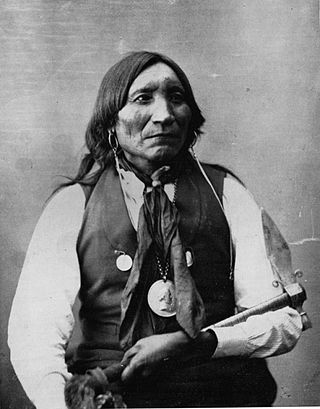Satanta can refer to:
Setanta may refer to:

Satanta is a city in Haskell County, Kansas, United States. As of the 2020 census, the population of the city was 1,092. Every year there is a celebration of Satanta's Indian heritage called Satanta Day.
White bear may refer to:
Santana may refer to:

Satanta was a Kiowa war chief. He was a member of the Kiowa tribe, born around 1820, during the height of the power of the Plains Tribes, probably along the Canadian River in the traditional winter camp grounds of his people.

Kicking Bird, also known as Tene-angop'te, "The Kicking Bird", "Eagle Who Strikes with his Talons", or "Striking Eagle" was a High Chief of the Kiowa in the 1870s. It is said that he was given his name for the way he fought his enemies. He was a Kiowa, though his grandfather had been a Crow captive who was adopted by the Kiowa. His mysterious death at Fort Sill on May 3, 1875, is the subject of much debate and speculation. Though he was a great warrior who participated in and led many battles and raids during the 1860s and 1870s, he is mostly known as an advocate for peace and education in his tribe. He enjoyed close relationships with whites, most notably the Quaker teacher Thomas Battey and Indian Agent James M. Haworth. The close relationships he enjoyed with whites engendered animosity among many of the Kiowas, making him a controversial figure. He would become the most prominent peace chief of the Kiowas, following the lead of a previous head chief, Dohasan. Kicking Bird was diplomatically active and signed the Little Arkansas Treaty of 1865 and the Medicine Lodge Treaty of 1867 and was instrumental in moving his people to reservations.

Satank was a prestigious Kiowa warrior and medicine man. He was born about 1800, probably in Kansas, and killed June 8, 1871. An able warrior, he became part of the Koitsenko, the society of the bravest Kiowa warriors. He led many raids against the Cheyennes, the Sacs, and the Foxes. As the white settlers' importance increased, he raided settlements, wagon trains, and even army outposts.
The Cimarron Valley Railroad was built c. 1912 and purchased from Burlington Northern Santa Fe Railroad in February 1996. It runs over former C.V. and Manter Subdivisions of the Atchison, Topeka and Santa Fe Railroad tracks in Oklahoma, Colorado and Kansas. One line runs from Dodge City, KS to Boise City, OK, the other from Satanta, KS to Springfield, CO. It runs a total of 254 miles of track primarily hauling agricultural commodities, along with sand, cement, poles, pipe, and fertilizers. CVR was one of several short-line railroads operated by The Western Group of Ogden, Utah.
The Warren Wagon Train raid, also known as the Salt Creek massacre, occurred on May 18, 1871. Henry Warren was contracted to haul supplies to forts in the west of Texas, including Fort Richardson, Fort Griffin, and Fort Concho. Traveling down the Jacksboro-Belknap road heading towards Salt Creek Crossing, they encountered William Tecumseh Sherman. Less than an hour after encountering the famous General, they spotted a rather large group of riders ahead. They quickly realized that these were Native American warriors, probably Kiowa and/or Comanche. The corn train quickly shifted into a ring formation, and all the mules were put into the center of the ring. The warriors destroyed the corn supplies, killing and mutilating seven of the wagoneer's bodies. Five men managed to escape, one of which was Thomas Brazeale who reached Fort Richardson on foot, some 20 miles away. As soon as Col. Ranald S. Mackenzie learned of the incident, he informed Sherman. Sherman and Mackenzie searched for the warriors responsible for the raid. In the end, notwithstanding the intervention of Guipago, well equipped with loaded rifles and revolvers and ready to fight, three of the war leaders involved were arrested at Fort Sill: Satanta, Satank, and Ado-ete. Satank attempted to escape and was killed while traveling to Fort Richardson for trial. The other two were tried and convicted of murder.
Santanta may be an alternate spelling of:

The Trial of Satanta and Big Tree occurred in May 1871 in the town of Jacksboro in Jack County, Texas, United States. This historic trial of Native American War Chiefs of the Kiowa Indians Satanta and Big Tree for the murder of seven teamsters during a raid on Salt Creek Prairie near Jacksboro, Texas, marked the first time the United States had tried Native American Chiefs in a state court. The trial attracted national and international attention. The two Kiowa leaders, with Satank, a legendary third War Chief, were formally indicted on July 1, 1871, and tried shortly thereafter, for acts arising out of the Warren Wagon Train Raid.
James Auchiah (1906–1974) was a Kiowa painter and one of the Kiowa Six from Oklahoma.

White Horse was a chief of the Kiowa. White Horse attended the council between southern plains tribes and the United States at Medicine Lodge in southern Kansas which resulted in the Medicine Lodge Treaty. Despite his attendance at the treaty signing he conducted frequent raids upon other tribes and white settlers. Follower of such elders as Guipago, Satanta and old Satank, he was often associated with Big Tree, this one too a young war leader in the Kiowa nation.

Guipago was the last Principal Chief of the Kiowa tribe. He was a member of the Koitsenko, the Kiowa warrior elite, and was a signer of the Little Arkansas Treaty in 1865.

The 14th Field Artillery Regiment is a parent field artillery regiment of the United States Army, currently represented in the Regular Army by its 1st Battalion, a HIMARS unit with the 75th Field Artillery Brigade at Fort Sill, Oklahoma.

Big Bow was a Kiowa war leader during the 19th century, an associate of Guipago and Satanta.
Mamanti, also known as Swan was a Kiowa medicine man.

They Rode West is a 1954 American Western film directed by Phil Karlson. It reunites the stars of The Caine Mutiny, Robert Francis and May Wynn. It also stars Donna Reed and Philip Carey. Based on the story Wood Hawk by Leo Katcher, it was filmed at the Corriganville movie ranch, using the same fort set that was built in 1948 for the John Ford film "Fort Apache."

Big Tree, Kiowa: Ado-ete, was a noted Kiowa warrior and chief. He was a loyal follower of the fighting chiefs party, and conducted frequent raids upon other tribes and white settlers, often being associated with Tsen-tainte.

K-190 is a 24.172-mile-long (38.901 km) east–west state highway in the U.S. state of Kansas. K-190's western terminus is at U.S. Route 160 (US-160) east of the community of Hickok, and the eastern terminus is at US-83 and US-160 south of the city of Sublette. K-190 travels mostly through flat rural farmland, however it does run through the city of Satanta where it is co-designated as US-56.